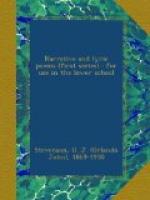Back comes the Chief in triumph,
Who, in the hour of fight,
Hath seen the Great Twin Brethren
In harness on his right.
Safe comes the ship to haven, 765
Through billows and through gales,
If once the Great Twin Brethren
Sit shining on the sails.[68]
Wherefore they washed their horses
In Vesta’s holy well, 770
Wherefore they rode to Vesta’s door,
I know, but may not tell.
Here, hard by Vesta’s Temple,
Build we a stately dome
Unto the Great Twin Brethren 775
Who fought so well for Rome.
And when the months returning
Bring back this day of fight,
The proud Ides of Quintilis,
Marked evermore with white, 780
Unto the Great Twin Brethren
Let all the people throng,
With chaplets and with offerings,
With music and with song;
And let the doors and windows 785
Be hung with garlands all,
And let the Knights be summoned
To Mars without the wall:
Thence let them ride in purple
With joyous trumpet-sound, 790
Each mounted on his war-horse,
And each with olive crowned;
And pass in solemn order
Before the sacred dome,
Where dwell the Great Twin Brethren 795
Who fought so well for Rome!”
—Macaulay.
[1] Ten years after the siege of Rome by Lars Porsena, the Latins, under Mamilius of Tusculum, made a last attempt to force the Romans to restore the Tarquin kings. A battle was fought at Lake Regillus (B.C. 498) between the Latins and the Romans, in which the Romans were successful. Lake Regillus has disappeared and its exact site is no longer known. It is supposed to have been situated at the foot of the Tusculan hills, about ten miles to the southeast of Rome.
[2] Castor and Pollux were twin deities, the sons of Zeus (or Jupiter). Their birthplace was Sparta, in Greece, and there they had their chief temple.
[3] Ides of Quintilis. The fifteenth of July.
[4] lictors. The body-guard of the magistrates, armed with rods and axes.
[5] The Knights. The cavalry.
[6] Castor, and Mars. The temples of Castor and of Mars.
[7] Forum. The market-place, or public square.
[8] Yellow River. The Tiber, so called from its yellow sands.
[9] Sacred Hill. A famous hill about three miles from Rome.
[10] Martian Kalends. The first of March, on which a feast to Juno was held.
[11] December’s Nones. December the fifth, on which was held a feast to Faunus, a god of the flocks and herds.
[12] whitest. We should say “a red-letter day.”




